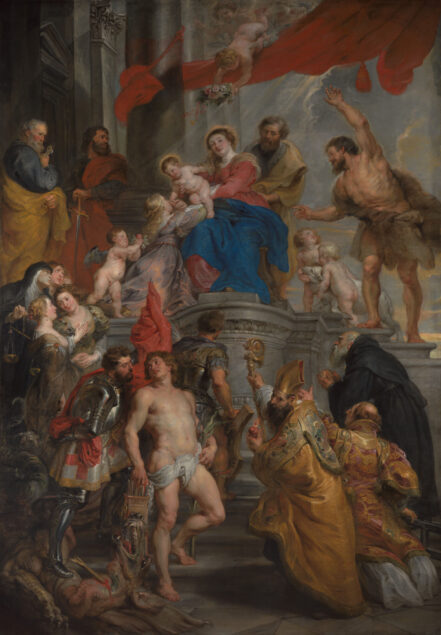In August 2025, the Royal Museum of Fine Arts Antwerp (KMSKA) completed the first phase of its large-scale restoration project, Studio Rubens. For two years, restorers worked in the gallery on the monumental Enthroned Madonna Adored by Saints. Thorough conservation has revitalized the artwork, revealing its original vivid colors and swirling figures. The museum is now preparing for the second phase of the project: the treatment of the Adoration of the Magi.

Peter Paul Rubens (1577-1640), ‘Enthroned Madonna Adored by Saints’ (after restoration), 1628
Royal Museum of Fine Arts, Antwerp
A Restoration Studio in the Gallery
Because the Enthroned Madonna was too large to be moved to a conservation studio, the KMSKA decided to carry out the restoration on site in the Rubens Gallery allowing visitors to follow the full restoration process. The project extends beyond a simple cleaning of the altarpieces; it also involves extensive research into Rubens’s creative process. An international team of restorers, researchers, and Rubens experts meticulously examined every detail of the Enthroned Madonna, and the first phase of this work has already yielded significant new insights.
New findings from the Enthroned Madonna altarpiece contradict the common belief that Rubens was responsible for the preparatory studies, while his workshop completed the final paintings. During a study day with the University of Antwerp, experts concluded that the initial studies for this work were likely created by his assistants. Conversely, a panel of specialists determined that Rubens executed a large portion of the final painting himself, providing a new perspective on his workshop’s dynamic.
MA-XRF scans helped identify Rubens’s creative process by exposing older paint layers. The scans show how the artist traced and refined earlier poses in an iterative manner. A striking example is the foreground figures of Saints George and Sebastian, whose final poses were altered an no less than seven times.
Second Phase
The next altarpiece scheduled for restoration is The Adoration of the Magi. This phase of the project will build upon the techniques of the previous restoration while also introducing new challenges. Notably, the work’s considerable weight—due to being painted on a panel—requires special handling, and a custom easel has already been modified in the studio to support it.
2027: Year of Rubens
The restoration of The Adoration of the Magi will be completed in 2027, when Antwerp celebrates the 450th anniversary of Rubens’ birth with a festive Rubens Year. In that year, the KMSKA will present, together with the Rubens House, the exhibition Rubens and the World. This exhibition, based on international research, will highlight how Rubens enriched his art with models, materials, and motifs from all corners of the world.


